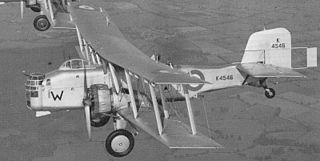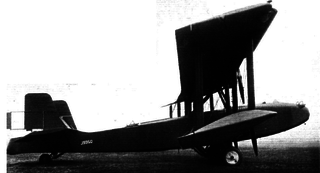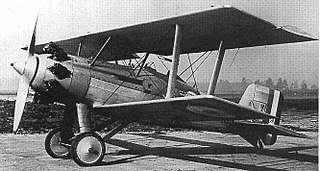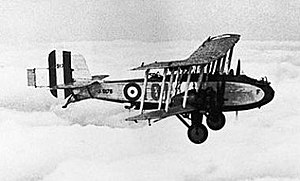
The Short Stirling was a British four-engined heavy bomber of the Second World War. It has the distinction of being the first four-engined bomber to be introduced into service with the Royal Air Force (RAF) during the war.

The Boulton Paul Defiant is a British interceptor aircraft that served with the Royal Air Force (RAF) during World War II. The Defiant was designed and built by Boulton Paul Aircraft as a "turret fighter" to meet the RAF requirement for day and night fighters that could concentrate their firepower on enemy bombers which were not expected to have fighter escorts due to the distance from Germany to the United Kingdom. The Defiant had all its armament in a dorsal turret offering the ability to fire in most directions. The same principle was used in the Royal Navy's Blackburn Roc which was also built by Boulton Paul.

The Handley Page Halifax is a British Royal Air Force (RAF) four-engined heavy bomber of the Second World War. It was developed by Handley Page to the same specification as the contemporary twin-engine Avro Manchester.

The Fairey Fox was a British light bomber and fighter biplane of the 1920s and 1930s. It was originally produced in Britain for the RAF, but continued in production and use in Belgium long after it was retired in Britain.

The Hawker Hart is a British two-seater biplane light bomber aircraft that saw service with the Royal Air Force (RAF). It was designed during the 1920s by Sydney Camm and manufactured by Hawker Aircraft. The Hart was a prominent British aircraft in the inter-war period, but was obsolete and already side-lined for newer monoplane aircraft designs by the start of the Second World War, playing only minor roles in the conflict before being retired.

The Boulton Paul P.75 Overstrand was a twin-engine biplane medium bomber designed and produced by the British aircraft manufacturer Boulton Paul. It was the final example of a series of biplane medium bombers that had served in the Royal Air Force since the First World War, starting with the likes of the Vickers Vimy and Handley Page Type O. The Overstrand was also the first aircraft to be fitted with a fully-enclosed power-operated turret.

The Handley Page Heyford was a twin-engine biplane bomber designed and produced by the British aircraft manufacturer Handley Page. It holds the distinction of being the last biplane heavy bomber to be operated by the Royal Air Force (RAF).

The Vickers Virginia was a biplane heavy bomber of the British Royal Air Force, developed from the Vickers Vimy.

The Handley Page Hinaidi was one of two twin-engine bombers built by Handley Page that served with the Royal Air Force between 1925 and 1935. The aircraft was developed from the Handley Page Hyderabad and named after Hinaidi, an RAF station in Iraq.

The Hawker Horsley was a British single-engined biplane bomber of the 1920s. It was the last all-wooden aircraft built by Hawker Aircraft, and served as a medium day bomber and torpedo bomber with Britain's Royal Air Force between 1926 and 1935, as well as the navies of Greece and Denmark.

The Westland Wapiti was a British two-seat general-purpose military single-engined biplane of the 1920s. It was designed and built by Westland Aircraft Works to replace the Airco DH.9A in Royal Air Force service.

The Avro 549 Aldershot was a British single-engined heavy bomber aircraft built by Avro.

The Short Springbok was a two-seat, all-metal reconnaissance biplane produced for the British Air Ministry in the 1920s. All together six aircraft of the Springbok design were built but none entered service with the armed forces.

The Fairey Fawn was a British single-engine light bomber of the 1920s. It was designed as a replacement for the Airco DH.9A and served with the Royal Air Force between 1924 and 1929.

The Boulton & Paul Bugle was a heavy bomber designed and produced by the British manufacturing group Boulton & Paul.
The Boulton & Paul P.7 Bourges was a prototype British twin-engined biplane day bomber built by Boulton & Paul to replace the Airco DH.10 Amiens. Despite demonstrating excellent performance and manoeuvrability, only three prototypes were built, post World War I cost cutting leading to the DH.10 not being replaced.

The sole Boulton & Paul P.32 was a British three-engined biplane built to an Air Ministry specification for a long range night bomber. A lack of engine availability slowed construction and by the time it went for tests the thinking on bomber types had moved on.

The Boulton & Paul P.33 Partridge was a single seat single-engined biplane fighter designed to an Air Ministry specification. One prototype was ordered and built for trials in 1928, but it was not put into production.

The Boulton & Paul P.15 Bolton was a one-off experimental twin-engined reconnaissance biplane ordered by the Air Ministry to sustain Boulton & Paul's development of steel-framed aircraft early in the 1920s. It was the RAF's first metal-framed aircraft.
The Sopwith Cobham was a British twin-engined triplane bomber aircraft designed and built by the Sopwith Aviation Company during the First World War. The only twin-engined aircraft built by Sopwith, the Cobham did not fly until after the end of the war, and was unsuccessful due to the failure of its engines, only three prototypes being built.



















